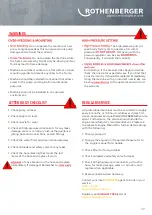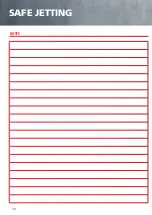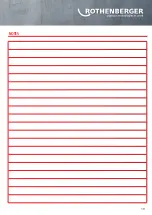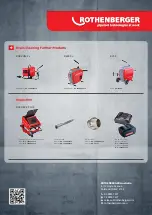
OPERATOR’S HAND SIGNALS
This section offers a set of hand-signals, or non-verbal
communications, to be utilised when carrying out water
jetting operations.
•
Thumb pointing upwards with the
rest of the hand closed. Starting at
shoulder height, the arms move up
and down.
•
Formulate a fist. Starting at
shoulder height, move the
arm back and forth.
•
First finger pointing up with the
rest of the hand closed. Move the
hand in a circular motion.
•
First finger pointing down with the
rest of the hand closed. Move the
hand in a circular motion.
If an accident occurs in which pressurised water
penetrates, or appears to have penetrated the skin,
one must seek medical assistance immediately.
In situations where medical examination is not
immediately possible, such as when an injury is
sustained in a remote location, appropriate first aid
should be applied, and the patient observed closely
until medical treatment becomes available.
All operators engaged in commercial and industrial
water blasting activities should carry an easily
accessible, waterproof medical alert card. This card
should:
• Outline the likely nature of particular injuries and
post-accident infections that may be caused by high
pressure water blasting;
• Provide details of the necessary first-aid treatment
that must be applied immediately and maintained
until medical treatment may be arranged; and
• Provide the name(s) and phone numbers of medicos
that should be contacted in order to obtain expert
medical advice for the treatment of high-pressure
water blasting injuries.
Additionally, the card may:
• Identify the worker, and;
• Outline medical information concerning the worker,
such as one’s blood type, allergies, and other unique
conditions, such as asthma.
ACCIDENT REPORTING
•
: All accidents or injuries, regardless of
whether they are deemed to be ‘lost time’ or ‘no lost
time’ injuries, must be recorded, thus adhering to
the recommendations detailed in AS 1885.1.
Additionally, incidents deemed to be ‘near misses’
must also be recorded in an effort to provide an
accurate record of significant incidents that hold the
potential to lead to a serious injury in the workplace.
Consequently, appropriate measures may be
implemented to minimise or even eliminate these
potential hazards.
•
: In the event that a person is
injured as a result of the impact caused by a water jet,
the injury itself may appear insignificant and thus
provide little explanation as to the extent of the injury
sustained below the surface of the skin. While only
a small hole may be present, quantities of water may
have penetrated the skin, entering the flesh, deeper
tissues and organs, causing serious injury.
15
For those that sustain equipment related injuries whilst
operating the system, immediate hospital attention
is critical. In such cases, it is imperative that medical
personnel be apprised of all facts relevant to the injury
at hand.
EMERGENCY MEDICAL INFORMATION
Summary of Contents for ROBLAST JETTER
Page 1: ...ROTHENBERGER ROBLAST JETTER MANUAL ...
Page 18: ...SAFE JETTING 18 NOTES ...
Page 19: ...NOTES 19 ...




















